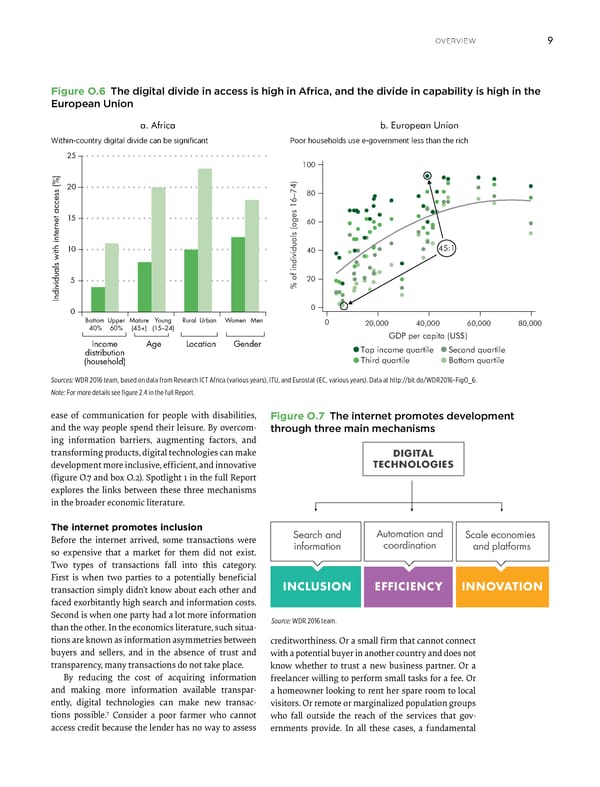overview 9 Figure O.6 The digital divide in access is high in Africa, and the divide in capability is high in the European Union a. Africa b. European Union Within-country digital divide can be significant Poor households use e-government less than the rich a. Africa b. European Union 25 100 ) 20 80 t access (%15 60 terne in 10 40 45:1 5 % of individuals (ages 16–74)20 Individuals with 0 0 Bottom Upper Mature Young Rural Urban Women Men 0 20,000 40,000 60,000 80,000 40% 60% (45+) (15–24) GDP per capita (US$) Income Age Location Gender Top income quartile Second quartile distribution Third quartile Bottom quartile (household) Sources: WDR 2016 team, based on data from Research ICT Africa (various years), ITU, and Eurostat (EC, various years). Data at http://bit.do/WDR2016-FigO_6. Note: For more details see figure 2.4 in the full Report. ease of communication for people with disabilities, Figure O.7 The internet promotes development and the way people spend their leisure. By overcom- through three main mechanisms ing information barriers, augmenting factors, and transforming products, digital technologies can make DIGITAL development more inclusive, efficient, and innovative TECHNOLOGIES (figure O.7 and box O.2). Spotlight 1 in the full Report explores the links between these three mechanisms in the broader economic literature. The internet promotes inclusion Search and Automation and Scale economies Before the internet arrived, some transactions were information coordination and platforms so expensive that a market for them did not exist. Two types of transactions fall into this category. First is when two parties to a potentially beneficial INCLUSION EFFICIENCY INNOVATION transaction simply didn’t know about each other and faced exorbitantly high search and information costs. Second is when one party had a lot more information Source: WDR 2016 team. than the other. In the economics literature, such situa- tions are known as information asymmetries between creditworthiness. Or a small firm that cannot connect buyers and sellers, and in the absence of trust and with a potential buyer in another country and does not transparency, many transactions do not take place. know whether to trust a new business partner. Or a By reducing the cost of acquiring information freelancer willing to perform small tasks for a fee. Or and making more information available transpar- a homeowner looking to rent her spare room to local ently, digital technologies can make new transac- visitors. Or remote or marginalized population groups tions possible.7 Consider a poor farmer who cannot who fall outside the reach of the services that gov- access credit because the lender has no way to assess ernments provide. In all these cases, a fundamental
 World Development Report 2016 Page 20 Page 22
World Development Report 2016 Page 20 Page 22